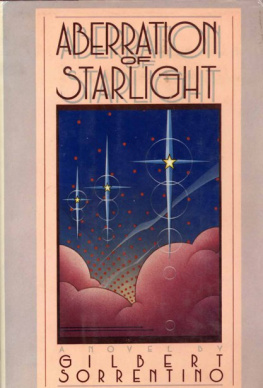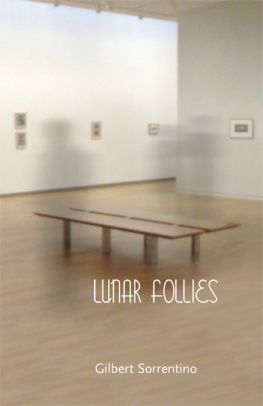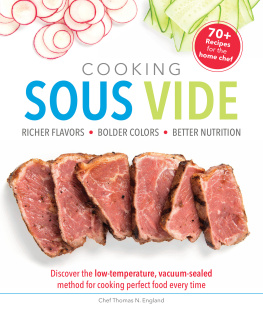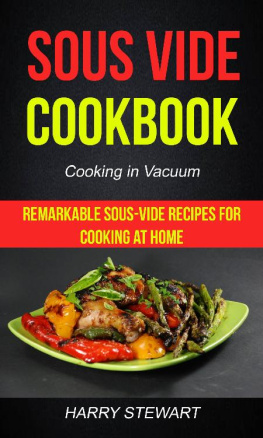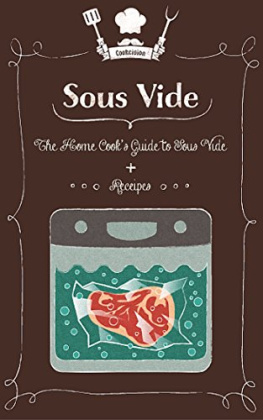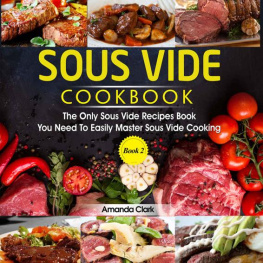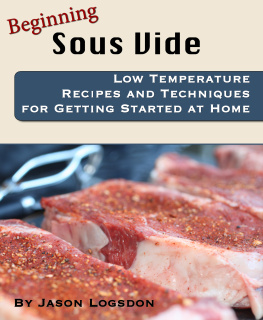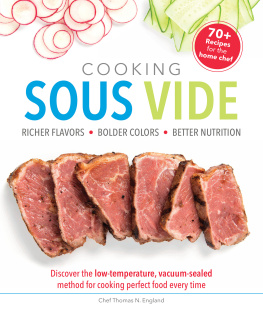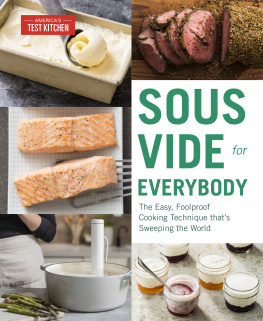Sous Vide Cookbook
Discover the 150 Best Sous Vide Recipes for Your Low Temperature Long Time Cooking at Home
Nerea Sorrentino

Text Copyright Nerea Sorrentino
All rights reserved. No part of this guide may be reproduced in any form without permission in writing from the publisher except in the case of brief quotations embodied in critical articles or reviews.
Legal & Disclaimer
The information contained in this book and its contents is not designed to replace or take the place of any form of medical or professional advice; and is not meant to replace the need for independent medical, financial, legal or other professional advice or services, as may be required. The content and information in this book have been provided for educational and entertainment purposes only.
The content and information contained in this book has been compiled from sources deemed reliable, and it is accurate to the best of the Author's knowledge, information and belief. However, the Author cannot guarantee its accuracy and validity and cannot be held liable for any errors and/or omissions. Further, changes are periodically made to this book as and when needed. Where appropriate and/or necessary, you must consult a professional (including but not limited to your doctor, attorney, financial advisor or such other professional advisor) before using any of the suggested remedies, techniques, or information in this book.
Upon using the contents and information contained in this book, you agree to hold harmless the Author from and against any damages, costs, and expenses, including any legal fees potentially resulting from the application of any of the information provided by this book. This disclaimer applies to any loss, damages or injury caused by the use and application, whether directly or indirectly, of any advice or information presented, whether for breach of contract, tort, negligence, personal injury, criminal intent, or under any other cause of action.
You agree to accept all risks of using the information presented inside this book.
You agree that by continuing to read this book, where appropriate and/or necessary, you shall consult a professional (including but not limited to your doctor, attorney, or financial advisor or such other advisor as needed) before using any of the suggested remedies, techniques, or information in this book.
Table of Contents
Introduction
Many top restaurants across the globe use the sous vide cooking technique to give their meals a unique taste. If you cant let a day pass without dining in a certain eatery outlet, then you must have had a meal prepared with sous vide, and you can't resist taking their meals regularly.
The secret behind the sous vide tasty meals is its ability to control the heat evenly. Back in the day, many people have attempted different cooking techniques on how to maintain the required heating when roasting, braising, cooking and keeping the food warm, but all in vain.
Due to such problems, people thought of different ways to accomplish their desires and introduced ovens and stoves that helped in some ways. That wasn't the end of it all, there were more innovations. In no time, the idea of sous vide came into being. The famous chef George Pralus discovered the idea of sous vide in the mid-1970s. The chef was trying out a different cooking technique that will create an optimal environment for cooking and minimize extra costs.
As years passed, chef Bruno Goussault advanced the original technique from Chef George and started preparing meals for Air France travelers in the first class. After realizing the idea was worth the trial, he kept on with the innovation and after two decades, the idea had spread globally as the ultimate best cooking technique.
That is why many up-to-date restaurants and other eatery points use sous vide cooking to satisfy their customers.
Chapter 1: What you Need to Know About Sou Vide
We all want to make that perfect meal, and enjoy it. But we end up being disappointed. Sometimes, the food we are preparing end up burning because of our busy schedules.
Suppose you face such troubles especially when cooking meat, this book is ideal for you. In most cases, we cook meat and end up overcooking it without knowing. Some sides get fully-cooked while other parts become are still rare. The problem happens because of uneven heat distribution. However, if you want to get out of all these troubles, you simply need to try sous vide cooking. You will make the best meals to enjoy with your family without many struggles. With time, you will realize your family will enjoy the meals more than ever before. Before we move on, let us explain what a sous vide is.
Understanding a sous vide
It is also known as vacuum cooking, whereby you put the food you want to cook along with all the ingredients in a bag, then you seal it. The next step is to put the food in water for a given period under temperatures of between 130F and 160F.
Since the process is somehow dangerous, you must put all the safety precaution measures in place to avoid some accidents. For example, when using the tongs or other kitchen equipment to put the meal in water, you need to wear gloves to avoid water splashing on your skin.
Again, as you seal the bags or sometimes called pouches, you want to do whatever you can to ensure there is less air. This is why many people say you will vacuum seal the bagsyou suck out all the air. You can purchase special bags for cooking the Sous Vide way or you can use Ziploc freezer bags. You will have to make sure that you seal the freezer bags well so any ingredients and juices don't leak out of the bag and into the water.
If you wonder why sous vide food tastes great is because all the flavors and aroma remain in the food since the bag is sealed. No juices escape from the food as it is in the case of traditional cooking.
For example, when baking, pan-frying or grilling, you expose the food, giving room for the aroma and juices to escape. In the end, your food loses some taste than you had expected.
Cooking with sous vide is convenient; you only need to prepare the meal, seal it in a bag, and allow it to cook for the required time. The whole process is simple and you don't have to struggle with the hard techniques involved in cooking.
Sous Vide Cooking Main Steps
Although following a recipe while using sous vide can be tricky at times, do not worry because all the 150 recipes available in this cookbook are easy and straightforward to follow. You only need to read each step at a time and understand. Do not skip a single step because it contributes a lot to the final meal. Generally, you will have to follow the following three steps when cooking the sous vide way.
Step one- Preparation: Have your immersion or precision cooker attached to your container with water or kettle. Every recipe has a specific cook time and the required temperature. Set the time according to the recipe guidelines on the immersion circulator. Once the immersion circulator has reached the set temperature, you then put the sealed food in the water to start cooking. At this point, you have to be cautious because the water is hot, and it can burn your skin. That is why you must have tongs or gloves to use when immersing the food in water to cook. Avoid the splashes at all costs.
Step two- After you have done all the required preparations like mixing ingredients and cutting veggies, you now put everything in a saleable bag ready to be immersed in water. You can use the Ziplock freezer bags in case you haven't purchased the sous vide sealable bags. The key point to remember in step two is when sealing. Ensure the bag you are using doesn't have airthe reason for removing the air is to retain the nutrients of the food and taste. Again, when you remove all the air you effectively seal the bag, ready for cooking. Once everything is ready, including the water, you then immerse the bag in the water carefully.


